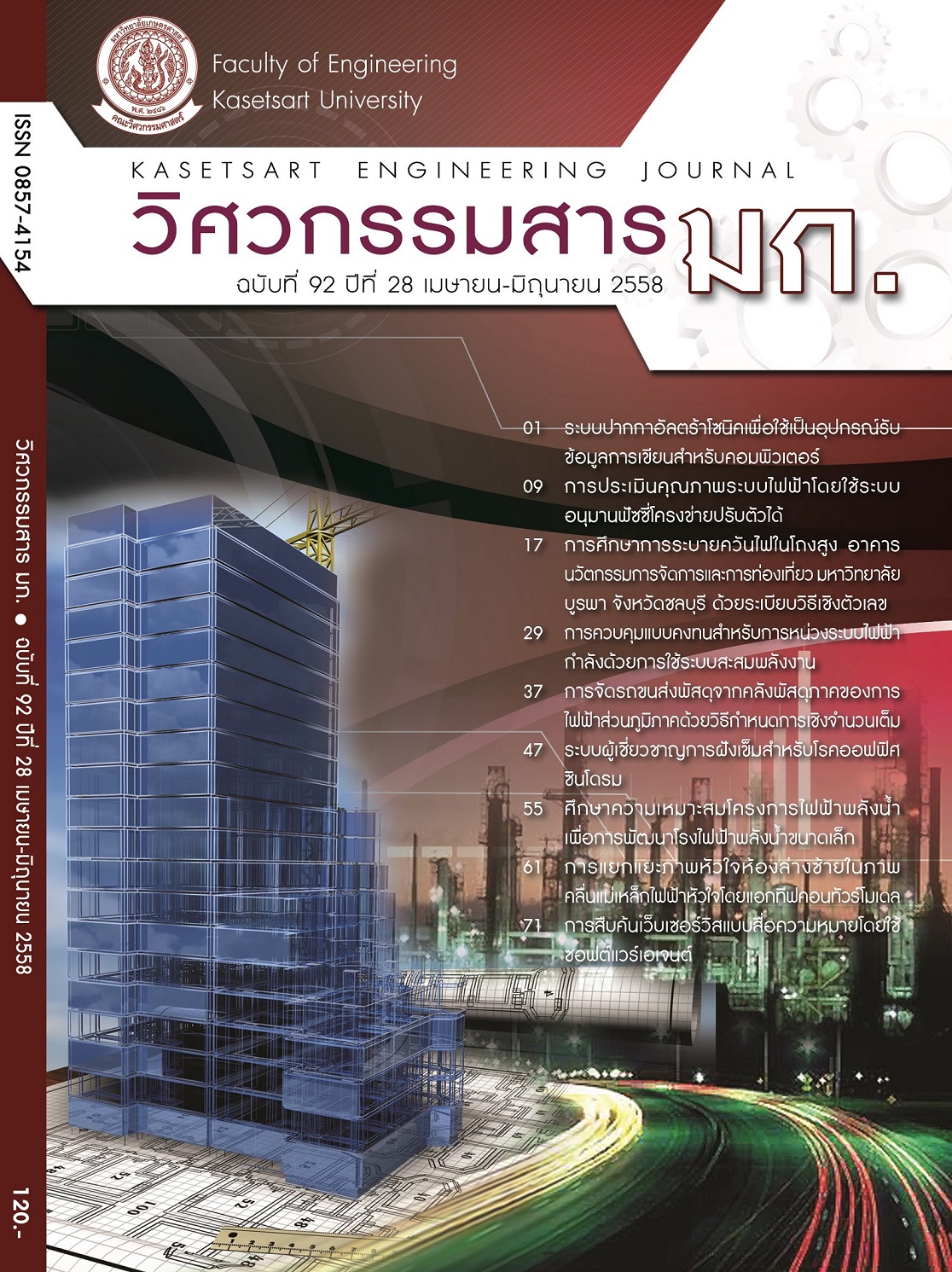การศึกษาการระบายควันไฟในโถงสูง อาคารนวัตกรรมการจัดการและการท่องเที่ยว มหาวิทยาลัยบูรพา จังหวัดชลบุรี ด้วยระเบียบวิธีเชิงตัวเลข
Keywords:
การจำลองด้วยระเบียบวิธีเชิงตัวเลข, การระบายควัน, แบบจำลองเพลิงไหม้พลศาสตร์, numerical simulation, smoke ventilation, fire dynamics simulatorAbstract
งานวิจัยนี้ศึกษาพฤติกรรมเพลิงไหม้และการแพร่กระจายควันไฟภายในอาคารนวัตกรรมการจัดการ และการท่องเที่ยว มหาวิทยาลัยบูรพา จังหวัดชลบุรี ด้วยแบบจำลองเพลิงไหม้พลศาสตร์ของไหลเชิงคำนวณ Fire Dynamics Simulator (FDS) โดยจำลองพฤติกรรมการแพร่กระจายของควันภายในอาคารเมื่อเกิดเพลิงไหม้ในบริเวณโถง atrium สำหรับกองเพลิง 3 ขนาด คือ กองเพลิงขนาด 2.2 MW 7.1 MW และ 14.2 MW ผลจากการจำลองแสดงให้เห็นว่า ถ้าพิจารณาเฉพาะอันตรายจากก๊าซคาร์บอนมอนอกไซด์อาจไม่มีความจำเป็นที่จะต้องติดตั้งระบบระบายควันไฟสำหรับกองเพลิงทุกขนาด แต่เมื่อพิจารณาถึงอุณหภูมิในช่องทางเดินไปสู่ทางหนีไฟ จะมีเพียงกองเพลิงขนาด 2.2 MW เท่านั้นที่ไม่จำเป็นต้องติดตั้งระบบระบายควันไฟ แต่สำหรับกรณีกองเพลิงขนาด 7.1 MW นั้น การติดตั้งระบบระบายควันทางกลเพียงอย่างเดียวก็เพียงพอ ส่วนกองเพลิงขนาด 14.2 MW จะต้องติดตั้งระบบระบายควันทางกลร่วมกับบ่อดักควัน จึงจะทำให้อุณหภูมิ ควันไฟเฉลี่ยที่ช่องทางเดินไปสู่ทางหนีไฟของทุกชั้นจึงมีค่าต่ำกว่า 49 องศาเซลเซียส และเมื่อพิจารณาถึงการแพร่กระจายของควันพบว่า ทุกขนาดกองเพลิงจำเป็นต้องติดตั้งระบบระบายควันทางกล ร่วมกับบ่อกักควันและม่านกั้นควันจึงจะทำให้ช่องทางเดินไปสู่ทางหนีไฟของทุกชั้นปลอดภัย และหากปิดหน้าต่างด้านหลังอาคารร่วมด้วย จะทำให้อาคารปลอดภัยยิ่งขึ้นสำหรับกองเพลิงขนาด 2.2 MW
A Numerical Simulation of Atrium Smoke Ventilation in the New Building of Faculty of Management and Tourism Burapha University at Chon Buri Province
This research numerically simulates fire and smoke spread behaviors in the new building of faculty of management and tourism Burapha University at Chon Buri province by a computation fluid dynamics fire model, Fire Dynamics Simulator (FDS). Simulations of smoke spread due to fire in the atrium of the building were performed for 3 fire sizes; 2.2 MW, 7.1 MW, and 14.2 MW. The outcome of this experiment, finally, found that in terms of the danger; in particular of carbon monoxide (CO), it is not necessary to install smoke ventilation systems for every size of fire samples. However, when the temperature in specific area; from corridor to fire exit, is considered, there is only 2.2 MW of fire size that smoke ventilation systems is not required. While it is enough to install only smoke ventilation systems for 7.1 MW of fire size, for 14.2 MW of fire size not only smoke ventilation systems is required, but smoke reservoir is also included in order to encourage the average temperature of smoke within the target area; corridor to fire exit, of every floor to achieve below 49 degree Celsius (oC). By considering the spread of smoke, besides, it is found that every size of fire samples requires the installment of smoke ventilation systems along with smoke reservoir and smoke curtain, in order to be able to achieve the safety purpose in the specific area; corridor to fire exit of every floor as consideration. In addition to 2.2 MW of fire size, the windows at the back of building should be closed for more safety.


